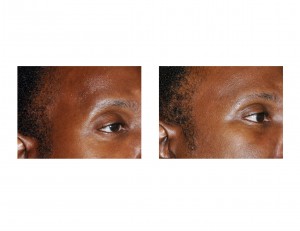Soft tissue augmentation of the face has gained popularity due to the use of a wide diversity of injectable fillers. From synthetic materials to fat, any soft tissue zone of the face can be injected. While facial implants have been around for many years for hard tissue augmentation, such as the chin, cheeks and jaw angles, there are many more soft tissue zones than there are hard tissue ones.

The contour shape of the temples is primarily influenced by how much fat and muscle lies underneath. Skin laxity is not an issue. Most commonly there is a slight concavity to the temples. But too much concavity or even excessive convexity is obvious and disrupts the shape of the overall face. How much temporal concavity is aesthetically acceptable is a matter of debate and belies any known established measurements. But when excessive the bony margins become obvious and presents an appearance of aging or even illness.
I have observed that placing a ruler or straight instrument between the anterior temporal line and the zygomatic arch, most people will have 1 to 3mms of concavity at the central or deepest area of the temples. When it exceeds 5mms or more, most people would view it as excessive temporal concavity.
For temporal hollowing, the most common treatments to date are injectable fillers. Treatment options include hyaluronic acid, PLLA and HA fillers as well as fat injections. Most of these injectable fillers are placed in the subcutaneous space between the skin and the superficial temporalis fascia. While this is where the frontal branch of the facial nerve passes, the risk of injury is low. Some do place fillers directly under the fascia into the temporalis muscle but this is less commonly done. In theory the muscle is a better place for longevity of fillers, particularly that of fat, but the push on the skin from under the temporalis fascia is weakly transmitted because the stiffer fascia pushes back against the soft filler.
While injectable fillers can be effective for temporal hollowing, they are not permanent and the volume needed for a single treatment is costly. It usually takes 2ccs of filler per side to have a visible effect. An alternative treatment for temporal hollowing is that of a synthetic implant. Made out of a flexible and very soft silicone material, temporal implants are inserted under the deep temporal fascia. It produces a result that is more significant that any injectable filler treatment and will create a permanent augmentation.

The simplicity and the permanence of specific shapes of synthetic facial implants should be considered as an option for the treatment of aesthetic temporal hollowing.
Dr. Barry Eppley
Indianapolis, Indiana


